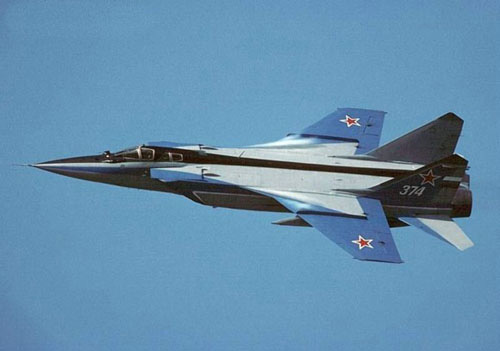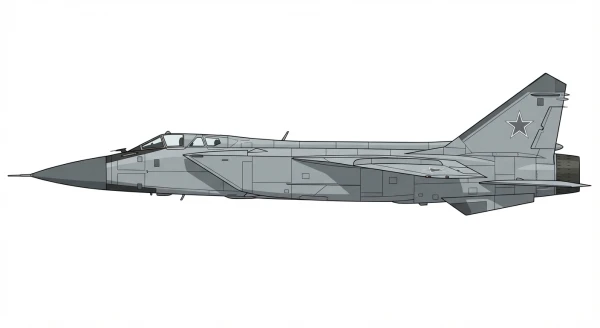MiG-31 Foxhound
Summary
| Category | Combat Aircraft |
| Origin country | 🇨🇳 Ex-USSR |
| Manufacturer | Mikoyan-Gurevitch |
| First flight | 16 September 1975 |
| Year introduced | 1983 |
| Number produced | 519 units |
| Average unit price | $45 million |
Description
The MiG-25 Foxbat surprised western military forces. It also terrified them, until the defection of one of these aircraft in Japan revealed the limits of the "Foxbat" myth. In addition to the usual defects associated with Soviet production (poor quality control, lower standards of finishing compared to the West...), NATO analysts understood that the MiG-25 was designed for speed, but that everything had been sacrificed in search of that speed. The Foxbat was unable to engage in maneuverable combat and was difficult to control at low altitude. Even worse, its powerful engines were so fragile that at maximum speed, they deteriorated even faster. Additionally, its fuel consumption was such that the MiG-25's supersonic endurance was too low. Therefore, as early as 1975, the Soviets decided to work on an improved version of the Foxbat, based on the same airframe. This new variant was intended to replace the MiG-25 in interception missions, as well as the old Tupolev Tu-128. In September 1975, a demonstrator, the Ye-155P, made its first flight. Mikoyan OKB engineers increased the amount of titanium and aluminum in the structure of the new aircraft, changed the propulsion system, increased the amount of fuel carried, and made it possible to exceed Mach 1 at low altitude. Soon, Western reconnaissance satellites detected the prototype at the Ramenskoye Flight Test Center near Moscow, where they frequently visited to seek out new Soviet equipment. After this discovery, the mysterious aircraft returned to obscurity: it would not be until 1985 that a Norwegian pilot would take a photograph of it in flight, and the 1991 Paris Air Show for it to be presented to the public. Meanwhile, the Soviets conducted numerous tests using about ten prototypes and pre-production aircraft before starting production in 1979. It was named MiG-31, with NATO giving it the designation "Foxhound".
The MiG-31 closely resembles the MiG-25, except that it carries a second crew member responsible for armament and onboard systems. Its wings and air intakes have been enlarged, which facilitates low-altitude flights but significantly limits the aircraft's capabilities in dogfighting, a mission it was not intended for. Its two D-30-F6 engines are theoretically capable of propelling it to Mach 3, although in practice, Mach 2.8 seems to be the true maximum speed. Large fuel tanks provide it with a long range: at Mach 2.35, a MiG-31 has a combat radius of nearly 720 kilometers. The Soviets determined that four aircraft were capable of covering a patrol area of 800 kilometers by 900 kilometers, which was and still is perfectly suitable for protecting the vast Russian airspace. The maximum range is 2,200 kilometers. To all this, the MiG engineers added a radar. And not just any radar. Starting with the MiG-31B version, the MiG-31 was equipped with the very first electronically scanned array radar, the Zaslon-A, developed by Phazotron. This Zaslon, capable of tracking ten targets and engaging four simultaneously, and also capable of looking downward and backward, makes the Foxhound vastly more formidable than its predecessors. Each MiG-31 also received an APD-518 data link, which can connect it not only to ground stations but also to Soviet AWACS aircraft and other MiG-31s. With such equipment, it is not surprising that, despite a very tight information blackout, the limited information that reached the West appeared as alarming to Western military and political leaders. But that was not the worst. In the great Soviet tradition, each aircraft or nearly every one has a particular type of missile. And long-range interceptors have always had the largest and most advanced missiles. In addition to a 23mm GSh-6-23 cannon, the MiG-31 can carry its lethal payload on four under-fuselage hardpoints and two under-wing hardpoints. Its main weapon is the R-33 (AA-9 Amos), capable of reaching up to 120 kilometers. Usually, four missiles are carried under the fuselage. In addition, two other shorter-range missiles are carried: either AA-6 Acrid, AA-8 Aphid, or AA-11 Archer. The AA-12 Adder is also planned to be integrated into the MiG-31.
In 1991, the MiG-31 was only in service with Soviet air units. Following the collapse of the USSR, Russia retained the majority of the aircraft, with only around forty joining the Kazakh Air Force. Being expensive to operate, the Foxhound has suffered significantly from the reduction in military budgets. Numerous aircraft are currently in storage, awaiting better conditions, although since the early 2000s, increased resources have been allocated to return them to airworthy status. It is estimated that currently, slightly less than 300 MiG-31s are operational in Russia, with an additional one hundred placed in reserve. Other sources suggest that there are only 100 to 150 operational aircraft. No aircraft have been exported, despite some attempts during the 1990s (India, Israel, recently Syria). In 1992, China acquired a production license for 700 aircraft, but it appears they have not utilized it. The MiG-31 remains useful today, and more modern variants are currently being developed by MiG in the hopes of modernizing the remaining aircraft still in service. Recently, Kazakhstan awarded MiG a contract to modernize twenty aircraft to the MiG-31BM standard. This standard, initially considered in the early 2000s but dismissed due to lack of funding, seems to be making a comeback. At present, there appear to be around six aircraft within the Russian Air Force. In total, just over 500 aircraft will have been produced.
Primary Variants:
- MiG-31 Foxhound-A: the initial production version, approximately 325 produced, all upgraded to the MiG-31BS standard.
- MiG-31B: a significantly improved version with the Zaslon-A radar, R-33 missiles, and inflight refueling capability; the MiG-31BS standard corresponds to first-generation aircraft upgraded to this standard.
- MiG-31D: designed for anti-satellite warfare, two prototypes built.
- MiG-31E: export version with reduced capabilities; no sales.
- MiG-31M Foxhound-B: appeared in 1991 but in development since the mid-1980s. New Zaslon-M radar (capable of engaging six targets at once), upgraded avionics, R-37 and R-77 missiles. Seven to fourteen examples produced before 1995.
- MiG-31BM: proposed overhaul by MAPO-MiG, modified Zaslon-AM radar (with mapping function and terrain tracking mode for air-to-ground engagements, capable of tracking 24 targets and engaging 10 simultaneously), new cockpit, and GLONASS navigation system, improved missiles (K-37M, K-73M, K-77-1, R-33S...). Standard accepted by the Russian Air Force but delayed due to lack of funding.
Technical specifications
| Version: MiG-31 Foxhound-A | |
|---|---|
| Crew | 1 pilot + 1 WSO |
| Operational range | 1,200 km (746 mi) |
| Maximum speed | 3000 km/h (1864 mph) |
| Wing area | 61.6 m² (663.1 sqft) |
| Wingspan | 13.5 m (44.2 ft) |
| Height | 6.2 m (20.2 ft) |
| Length | 22.7 m (74.4 ft) |
| Service ceiling | 20,600 m (67,585 ft) |
| Empty weight | 21,830 kg (48,127 lbs) |
| Max. takeoff weight | 46,200 kg (101,853 lbs) |
| Climb rate | 208.0 m/s (682.4 ft/s) |
| Powerplant | 2 x turbofans Soloviev D-30F6 delivering 9500 kgf each |
Current operating countries
| Country | Units | ||
|---|---|---|---|

|
Russia | 128 | |
All operators
Armament
Missiles payload:
- Air-to-Air Medium-Range Bisnovat R-40 (AA-6 Acrid)
- Air-to-Air Long-Range Vympel R-33 (AA-9 Amos)
- Air-to-Air Long-Range Vympel R-37 (AA-13 Arrow)
- Air-to-Air Short-Range Vympel R-60 / K-60 (AA-8 Aphid)
- Air-to-Air Short-Range Vympel R-73 (AA-11 Archer)
- Air-to-Air Medium-Range Vympel R-77 RVV-AE (AA-12 Adder)
- Hypersonic Air-to-Surface Kh-47M2 Kinzhal (AS-24 Killjoy)


